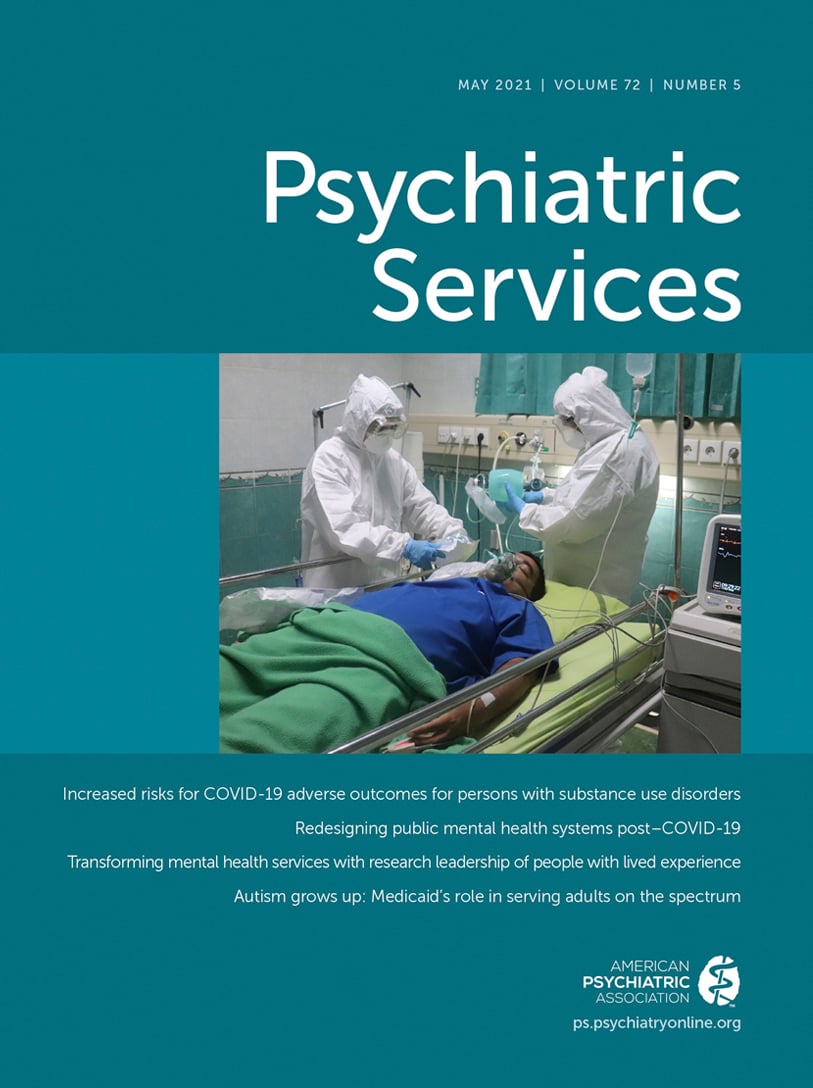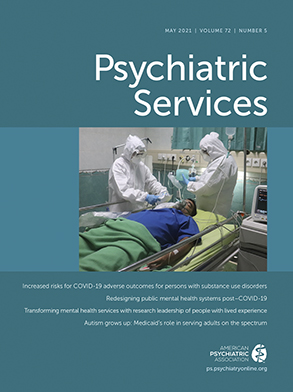The Missing Link(age): Multilevel Contributors to Service Uptake Failure Among Youths on Community Justice Supervision
Abstract
Objectives:
Methods:
Results:
Conclusions:
HIGHLIGHTS
Methods
JJ-TRIALS Research Cooperative
Procedures and Measures
Youth case records.
Justice agency staff and leadership surveys.
County characteristics.
Analysis plan.
| Characteristic | N | % |
|---|---|---|
| Youths | ||
| Male | 6,164 | 74.2 |
| Age (M±SD) | 14.9±1.6 | |
| Whitea | 3,997 | 49.4 |
| Hispanica | 1,698 | 21.6 |
| Current charge concerns alcohol or other substancea | 1,362 | 18.5 |
| Current charge violence relateda | 2,147 | 26.4 |
| On higher level of community supervisiona | 4,426 | 55.4 |
| M±SD | Range | |
|---|---|---|
| Site-level justice staff | ||
| Years of experience of staff | 15.3±3.2 | 6.8–20.2 |
| No. of youths in staff caseloads | 16.3±6.5 | 2.3–31.5 |
| Score on perceived competency to identify behavioral health needs and make service linkagesb | 38.0±1.9 | |
| Site-level juvenile justice organization | ||
| Intra-agency communicationb | 30.4±4.1 | |
| Job stressb | 35.1±3.9 | |
| Shared and collaborative practices with treatment providersc | 4.8±2.8 | |
| County | ||
| % of families with children below the poverty line | 18.2±6.3 | |
| % of families with children ages <18 who are uninsured | 7.0±3.4 | |
| % in urban setting | 86.8±14.2 | |
| No. of psychiatrists, licensed social workers, and psychologists per 100,000 youths | 37.4±27.8 |
Missing data.
Results
Contributing Characteristics and Outcomes
Youth characteristics.
Justice agency staff and organizational characteristics.
County characteristics.
Cascade outcomes.
| Cascade step | N | % |
|---|---|---|
| Screened for behavioral health needs (among 8,307 youths at 33 sites) | 5,942 | 71.5 |
| Days between juvenile justice intake and screening (M±SD)a | 103.5±145.2 | |
| Screened within 30 days of juvenile justice intake (among 5,861 youths at 33 sites) | 4,477 | 76.4 |
| Screened positive (among 8,307 youths at 33 sites) | 2,252 | 27.1 |
| Identified as being in need of substance use services (among 8,307 youths at 33 sites) | 4,294 | 51.7 |
| Referred for behavioral health services (among 8,250 youths at 32 sites) | 1,203 | 14.6 |
| Referred for behavioral health services (among 4,286 youths identified as being in need at 32 sites) | 940 | 21.9 |
| Days between substance use screening and referral (M±SD)b | 25.7±59.7 | |
| Referred within 30 days of screening (among 852 youths identified as being in need of services at 32 sites) | 375 | 44.0 |
| Treatment initiation (among 7,150 youths at 23 sites) | 638 | 8.9 |
| Treatment initiation (among 848 youths referred for services at 23 sites) | 572 | 67.5 |
| Engagement (among 5,968 youths at 20 sites) | 271 | 4.5 |
| Engagement (among 593 youths who had initiated treatment at 20 sites) | 271 | 45.7 |
| Continuing care (among 5,769 youths at 19 sites) | 152 | 2.6 |
| Continuing care (among 576 youths who had engaged in treatment at 19 sites) | 152 | 26.4 |
Predicting Cascade Steps
Screening.
| Variable | Screened for substance use (N=6,882) | In needof services (N=7,781) | Referredto servicesb (N=4,026) | Initiatedtreatmentc(N=731) | Substance usescreening within 30days of juvenilejustice intake(N=4,723) | Substance usetreatment referralwithin 30 days of screening (N=584) | ||||||
|---|---|---|---|---|---|---|---|---|---|---|---|---|
| Youths | ||||||||||||
| Male (reference: female) | 1.06 | .89–1.26 | 1.39*** | 1.24–1.56 | 1.18 | .94–1.48 | 1.23 | .71–2.13 | 1.14 | .90–1.46 | .97 | .47–2.02 |
| Age | .97 | .92–1.02 | 1.30*** | 1.26–1.35 | 1.00 | .94–1.07 | 1.04 | .88–1.24 | 1.09* | 1.01–1.17 | 1.51** | 1.17–1.94 |
| White (reference: non-White) | .99 | .83–1.18 | 1.40*** | 1.26–1.56 | 1.21 | .99–1.48 | .89 | .55–1.43 | .96 | .77–1.21 | 1.06 | .56–2.01 |
| Alcohol- or drug-related charge (reference: other charge) | 1.37** | 1.11–1.67 | — | — | — | — | — | — | .79 | .61–1.03 | — | — |
| Higher level of supervision (reference: lower level) | 2.92*** | 2.42–3.54 | 2.58*** | 2.28–2.92 | 4.89*** | 3.81–6.28 | 1.64 | .92–2.91 | 1.33* | 1.02–1.73 | .35* | .14–.89 |
| Site-level justice staff | ||||||||||||
| Years of experience of staff | 1.08 | .77–1.52 | 1.09 | .89–1.33 | .80** | .70–.92 | 1.07 | .79–1.43 | .66 | .43–1.09 | .82 | .60–1.12 |
| Staff caseload (no. of youths) | .97 | .86–1.10 | .93* | .86–1.00 | .95* | .91–1.00 | .97 | .86–1.09 | .97 | .83–1.13 | .89* | .80–.99 |
| Score on perceived competency to identify behavioral health needs and make service linkage | 1.11 | .68–1.79 | .91 | .68–1.18 | 1.04 | .85–1.26 | 1.21 | .76–1.90 | 1.33 | .71–2.56 | 1.03 | .67–1.58 |
| Juvenile justice organization | ||||||||||||
| Intra-agency communication | 1.15 | .79–1.67 | 1.02 | .86–1.20 | .97 | .87–1.09 | .69* | .51–.92 | .51** | .34–.78 | 1.12 | .86–1.46 |
| Job stress | 1.06 | .86–1.31 | 1.04 | .92–1.18 | .97 | .89–1.05 | .74* | .56–.97 | .58*** | .42–.80 | 1.10 | .93–1.30 |
| Shared and collaborative practices with treatment providers | 1.04 | .76–1.42 | .91 | .75–1.10 | 1.10 | .97–1.26 | .61*** | .46–.80 | 1.02 | .66–1.55 | .93 | .68–1.29 |
| County | ||||||||||||
| % of families with children below the poverty line | 1.03 | .92–1.15 | 1.02 | .96–1.08 | 1.02 | .97–1.06 | .97 | .88–1.08 | .84* | .73–.97 | .98 | .91–1.07 |
| % of families with children age <18 who are uninsured | 1.62*** | 1.09–2.42 | 1.12 | .92–1.37 | .91 | .79–1.05 | 1.37 | .98–1.91 | 1.48 | .93–2.35 | .80 | .60–1.05 |
| % urban | 1.04 | .97–1.11 | 1.00 | .96–1.04 | 1.00 | .98–1.03 | 1.05 | .98–1.13 | 1.02 | .93–1.11 | .96 | .91–1.01 |
| No. of psychiatrists, licensed social workers, and psychologists per 10,000 youths | 1.01 | .97–1.06 | 1.00 | .97–1.02 | .99 | .97–1.00 | .99 | .95–1.04 | 1.05 | .99–1.10 | .98 | .93–1.02 |
| % variance attributable to site | 50.7 | 27.7 | 13.5 | 29.8 | 60.5 | 27.5 | ||||||
| % difference from unconditional model | 18.6 | 10.0 | 14.7 | 32.0 | 10.0 | –7.1 | ||||||
| Fit statistics | ||||||||||||
| Akaike information criterion | 4,109.2 | 8,992.8 | 3,268.3 | 598.1 | 2,419.6 | 429.1 | ||||||
| Bayesian information criterion | 4,134.1 | 9,016.8 | 3,291.8 | 616.3 | 2,444.6 | 452.5 | ||||||
In need.
Referral.
Initiation.
Predicting Days to Screening and Referral
Discussion
Conclusions
Footnote
References
Information & Authors
Information
Published In
History
Keywords
Authors
Competing Interests
Funding Information
Metrics & Citations
Metrics
Citations
Export Citations
If you have the appropriate software installed, you can download article citation data to the citation manager of your choice. Simply select your manager software from the list below and click Download.
For more information or tips please see 'Downloading to a citation manager' in the Help menu.
View Options
View options
PDF/EPUB
View PDF/EPUBLogin options
Already a subscriber? Access your subscription through your login credentials or your institution for full access to this article.
Personal login Institutional Login Open Athens loginNot a subscriber?
PsychiatryOnline subscription options offer access to the DSM-5-TR® library, books, journals, CME, and patient resources. This all-in-one virtual library provides psychiatrists and mental health professionals with key resources for diagnosis, treatment, research, and professional development.
Need more help? PsychiatryOnline Customer Service may be reached by emailing [email protected] or by calling 800-368-5777 (in the U.S.) or 703-907-7322 (outside the U.S.).

